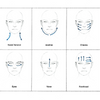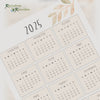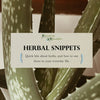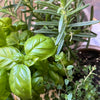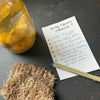How to Gua Sha Your Face and Body

Curious about Gua Sha and want to add it to your skincare routine? Well, we think that you should!
Gua Sha is a Traditional Chinese medicine (TCM) technique used to open up the meridians, or streams of energy (qi or chi) flow in our bodies. The techniques are intended to stimulate blood and lymphatic flow, which would in turn move out stagnant energy and toxins.
Performed anywhere along the body, Gua Sha can also help with muscle tension. There are twelve pairs of meridian lines, mirrored on the right and left sides of the body. You can't see them,
Gua Sha tools were traditionally the sides of ceramic spoons, bones or coins. Today they are typically carved and polished stone or stainless steel. They should fit comfortably in your hand and be cleanable. We have some available here if you need one, otherwise they are easy to find.
But WHY should you add Gua Sha to YOUR skincare routine? Because great skin happens when you are healthy. And Gua Sha is all about releasing tension (frown lines?) and encouraging circulation (goodbye toxins!).
I have seen a lot of directions online on how to Gua Sha, and some of the information contradicts each other. I think it is best to focus on the goal and intention of Gua Sha: we want to stimulate flow, so when in doubt, we should move towards the heart, and/or in an upwards and outwards direction.
How Tos
Let's start with clean hands, skin and tools. Add a light layer of oil to lubricate skin and allow tools to glide. Our Skin Cordial Face Serum and Snatch and Blast Body Oil are GREAT options!
Hold your Gua Sha Tool at a slight angle (35-45 degrees) firmly in your hand. You can use your fingers too. There is no set number of repetitions, but it is rather nice to pick a number to mentally count to, like a meditation. Gua Sha focuses on moving in one direction at a time.
Neck
I carry tension in my neck and shoulders, which can of course bring tension to your face, right? So I find it is easiest to start with easing these muscles first, which will reduce strain on the face.
Add a bit of Skin Cordial Face Serum or Snatch and Blast Body Oil to skin of the neck and upper shoulders. Use the flat side of a Gua Sha tool to scrape up and down the neck to base. If you find a knotted muscle, it's okay to apply pressure, but don't press on bones or your thyroid (front of the neck). You can be firm, but don't cause yourself any pain. Focus on long sweeps with the tool in one direction (upwards or downwards), and focus on applying light pressure to tension areas. Switch directions. Relax and let go: focus on release of negative energy.
- There are lymph nodes near the clavicle bones, behind the ears, and down and underneath the Sternocleidomastoid (SCM) muscle. Scrap in downward direction over these areas to move the lymphatic fluid.
- The Sternocleidomastoid (SCM) is the large muscle that runs from your skull to your clavicle. It allows you to turn and bend your neck, and tilt your neck. Turn your head a grab this muscle with your fingers: pinch up and down the muscle to release tension.
- The Splenius capitis and Splenius cervicis muscles are on back of your neck: from the base of skull (in the divot on side of spine) to shoulders. It helps to rotate your head from side to side. You can use your fingers or tool here also. Lots of tension in this area too.
Your skin may be a little red after doing this, as a result of increased blood flow. But it will fade. Leave the oil on your skin to keep it hydrated.
Face
Again, let's start with clean hands, skin and tools. Add a light layer of oil or lotion to lubricate skin and allow tools to glide. Our Skin Cordial Face Serum is a GREAT option! Remember to be gentle with your face: your skin is thin and delicate.

Jawline - Using the curved end of your Gua Sha stone, glide along your chin / jawline towards your ear. There are lymph nodes along the jaw (sometimes it sounds crunchy!)
Cheeks - Using the flat side of your Gua Sha stone, glide from center of face upwards and outwards towards your temples.
Eyes - Be extra gentle near your eyes as the skin is even thinner here. Glide your stone under the eyes and outwards to your temple. On the brow bone, glide the stone from the bridge of your nose along the brow bone out to your temple. Surprisingly, his area can also have some tension.
Nose - Glide the Gua Sha stone from tip of nose up to center of forehead. Think about how pets love this motion and you will understand.
Forehead - Two stoke types to the forehead. First, glide the Gua Sha stone from the eyebrows to the hairline. Starting in the center of the forehead and working out to the temples. Next, glide the Gua Sha stone from the center of forehead out to the temples. Start at the eyebrows and work up to the hairline.
Grab a glass of water and drink it. Stay hydrated!
The Rest of Your Body
Legs - Glide your Gua Sha stone (or a Fascia Blaster tool, which is awesome too!) in upwards motion, starting at your feet and moving towards the hips.
Arms - I read that to encourage Lung health, you should move from shoulder down to your hands. I also read that to encourage lease of muscle tension and lymphatic drainage, that you should move upwards towards your armpit. the armpit is a major lymphatic drainage point.
Chest - Glide your tools from center of chest out towards armpits, and also move from shoulders down (which is towards the heart)
Back - Glide tools downwards and outwards.
Belly - Glide tools in a circular motion around belly button, and from sides towards belly button.
Don't forget to clean your tools with gentle soap and water. when you are all done.
Don't you feel great and refreshed? You are gorgeous. Smile and enjoy!
A few articles that I found helpful when writing this article:
How to Use Gua Sha for Tension, Puffiness, and Lymphatic Drainage, Healthline, by Daley Quinn. https://www.healthline.com/health/pain-relief/how-to-massage-your-pressure-points
How to: Body Gua Sha with Dr. Kiah McGowan (TCM), KitsKinKind, https://kitskinkind.com.au/blogs/journal/how-to-body-gua-sha-with-dr-kiah-mcgowan
Neck Muscles, Cleveland Clinic. https://my.clevelandclinic.org/health/body/21670-neck-muscles
Lots of interesting videos here too; https://www.youtube.com/@Lanshin

